For main operation steps in Greenwich access plan product V1.0, refer to the
user guide in Greenwich documents.
Editing Electric Single-Line Graph
Electric single-line graph is the input of wind farm electric design. Before
substation siting, substation design, and power line design, finish the electric
single-line graph modification.
A complete wind farm electric single-line graph is consisted of one of the
typical structures listed below:
Turbine——Turbine transformer——Self-built substation
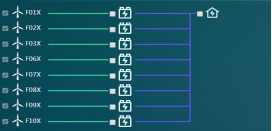
Turbine——Turbine transformer——Self-built substation——Grid-connected substation

Turbine——Turbine transformer——Self-built substation
Turbine——Turbine transformer——Self-built substation
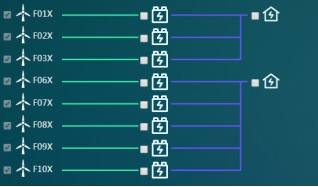
Turbine——Turbine transformer——Self-built substation——Grid-connected substation
Turbine——Turbine transformer——Self-built substation——Grid-connected substation

Turbine——Turbine transformer——Self-built substation——|—Grid-connected substation
Turbine——Turbine transformer——Self-built substation——|
Turbine——Turbine transformer——Self-built substation——|—Self-built substation
Turbine——Turbine transformer——Self-built substation——|
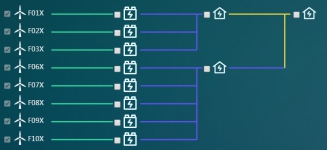
Turbine——Turbine transformer——Self-built substation——|—Self-built substation——Grid-connected substation
Turbine——Turbine transformer——Self-built substation——|
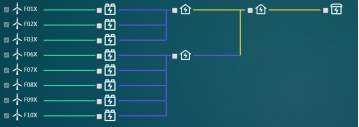
The typical structures listed above are only for your reference and you can
modify them based on the actual project situation.
Matching Electric Single-Line Graph
After you modify the electric single-line graph, perform the substation siting
operation. If there is any existing substation object, match the electric
single-line graph.
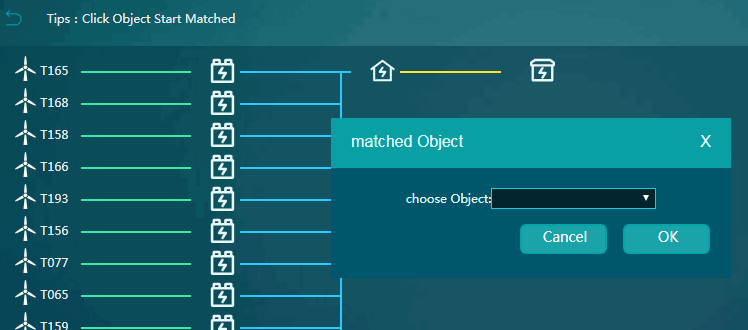
The substation object is classified into three categories: turbine transformer,
self-built substation, and grid-connected substation. No match is needed for
turbine transformers.
To match self-built substation, ensure the ingoing and outgoing voltage levels are consistent.
To match grid-connected substation, ensure the ingoing voltage level is the same as that in the access point and the accessed capacity does not exceed the accessible capacity of each access point bay and total accessible capacity of substation.
Note
A substation can be matched for only once.
Creating Grid-Connected Substation
Select access type when you create a grid-connected substation. Different access
types are corresponding to different input situations and judgement regulations.
The Substation capacity and Accessed new energy power capacity options are
mandatory and others are optional. Based on the information you input, the
system judges the accessible capacity of this substation. While judging the
capacity, the priority of data input is Minimum load of substation > Average
load of substation > Substation capacity * 20%. Take minimum load as an
example, the accessible capacity of grid-connected substation = Minimum load -
Accessed new energy power capacity.
Grid-connected device in/out of tower (optimized version for 10 kV switching
station) defines whether the self-built substation connected with this
grid-connected substation uses grid-connected device in/out of tower. The two
types of substations are only applicable for 10 kV switching station because the
devices have been optimized. Select one of them according to the local policy
because the acceptance degree of grid in different regions differs.
The Switching room capacity field is mandatory. The judgement rule of capacity
is that total accessible capacity is equal to switching room capacity. Whether
the power quality of user is higher than national standard refers to whether the
original power quality required by user is higher than national standard. The
selection of this option impacts the final accessibility judgement result.
Line category and Transportable capacity are mandatory options. The judgement
rule of capacity is that total accessible capacity is equal to power line
transportable capacity. No. of existing T-access circuit indicates whether the
target circuit has connected other T-access circuit and how the quantity is.
Your input here impacts the final accessibility judgement result.
Access Plan Calculation
- Grid-connected substation
Only grid-connected substations that pass the access judgement are listed here.
- Calculation scope.
The scope should include turbine and grid-connected substation. You can set up
inward and outward buffer.
- Calculation setup
When the total turbine capacity exceeds the total capacity of accessible
grid-connected substations (that it, some turbine locations might be abandoned),
choose to limit power of turbine to access more turbines. To calculate with
limited power, ensure the WTG group owns the power production time series file.
- Result display
After the calculation is completed, the results of every access point in
different grid-connected substations of WTG group are generated, and the
electric single-line graph is automatically generated (If there has already been
an existing one, it is overwritten by the newly generated one) and matched with
grid-connected substations. Double-click the Access related economics tab to
check the economic result details.







